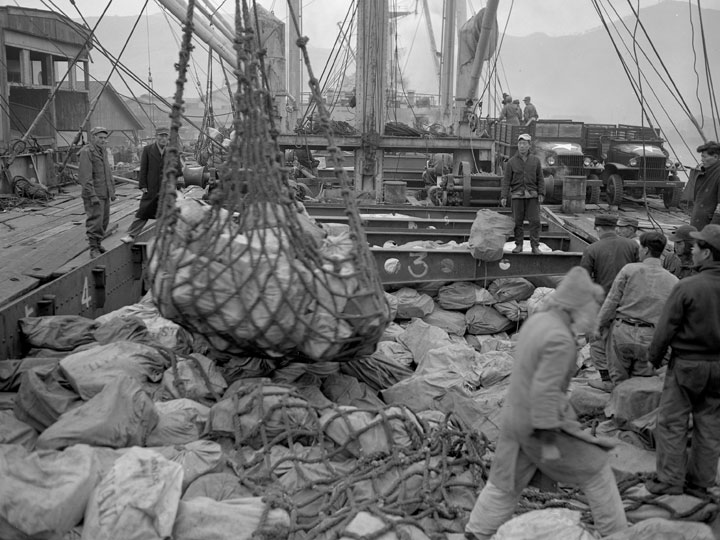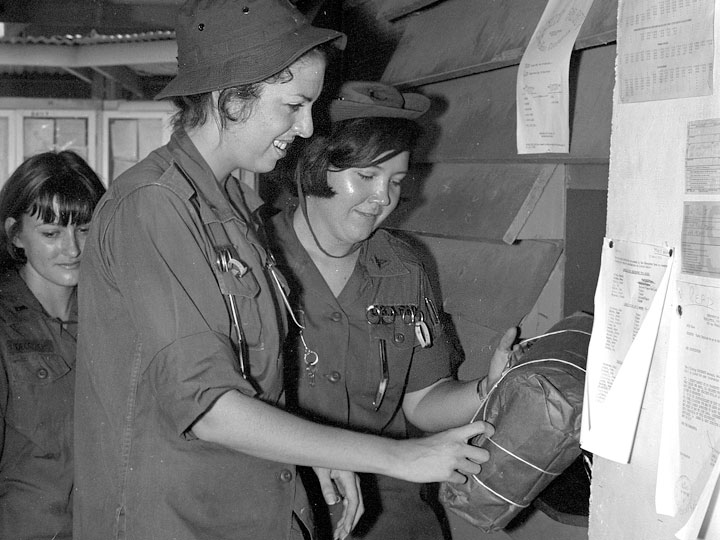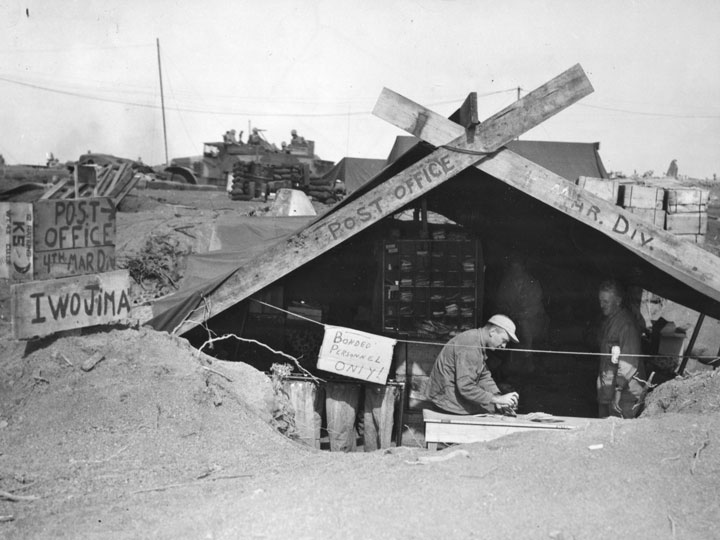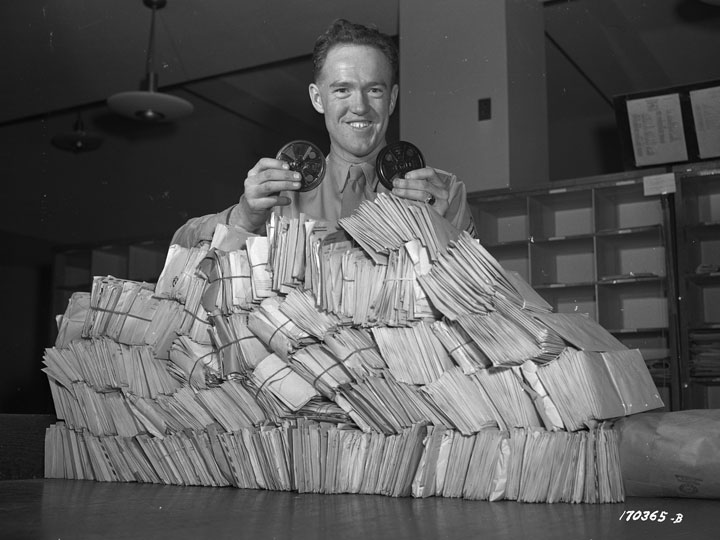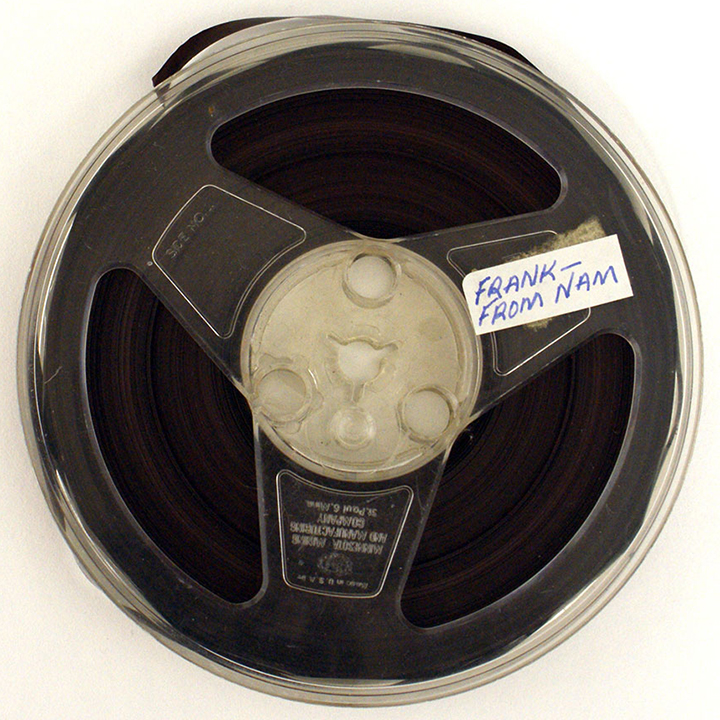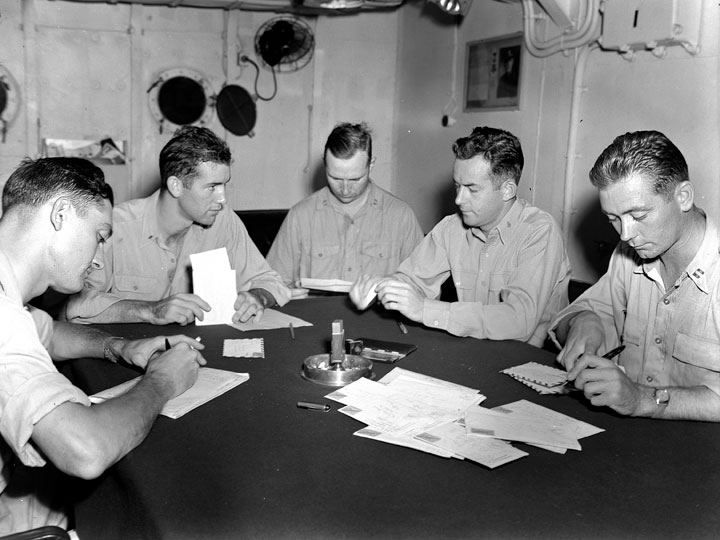Audio courtesy of the Library of Congress
(Marine Corps Combat Recordings LWO 5442 r3B5)
“4th Marine Division Post Office on Iwo Jima” Recorded on February 21, 1945
Interviewer: Perhaps you have often wondered what happens to all those hundreds of thousands of letters you write to the men overseas, the men of the various branches of the Armed Forces, how soon they’re delivered, how they're handled, and how quickly they reach the men when the men are actually in combat.
We’re speaking to you right now from Iwo Jima, and we have members of the Postal Department of the Veteran 4th Marine Division gathered around the microphone to tell you something about how that mail is handled. And I think you’ll be astonished to learn how efficiently and how quickly mail is brought to these men in actual combat and how quickly the mail from these men is taken back to the States.
First of all, we want you to meet Tech Sergeant E. T. Downing [phonetic] of 8
Carter Terrace in Somerville, Massachusetts and Sergeant B. D. Brian [phonetic] of Spartansburg, Pennsylvania, both postal clerks in the 4th Division post office. Ed, when did you bring your post office ashore? E. T. Downing: On April 6.
Interviewer: And when did you first start dealing mail out here on the island? E. T. Downing: Approximately April 6.
Interviewer: So does that mean it was the first mail that you had in? E. T. Downing: The first mail that came in.
Interviewer: How long did it take to sort that mail and get it out?
E. T. Downing: Same day. The mail is delivered the same day it comes in.
Interviewer: About how many sacks did you get that first day? E. T. Downing: Approximately 23 sacks, I believe.
Interviewer: And that’s about how many pieces of mail? Could you estimate that off hand? At 23 sacks that would be probably about 12 or -- E. T. Downing: About 65,000.
Interviewer: About 65,000 pieces of mails that came in on the first day. It was all sorted and delivered that first day. What is your particular job with the division post office?
E. T. Downing: I’m the NCO in-charge of the post office right now.
Interviewer: And you came ashore with the division post office. How about when you landed in Saipan, were you able to set up as quickly there as you have here? E. T. Downing: No, we set up quickly here than we did in Saipan.
Interviewer: I’m going to ask B.D. over here a question. This is Sergeant B. D.
Brian of Spartansburg, Pennsylvania. You were on Saipan, too, weren’t you? B.D. Brian: That’s right.
Interviewer: Well, how do you account for the much greater efficiency that you had on setting up your post office here?
B.D. Brian: Experience, I suppose, is the greatest factor.
Interviewer: Where else has this crew been through besides Saipan? B.D. Brian: They’ve been on the Marshall Islands and then Tinian.
Interviewer: That’s [indiscernible] and Saipan and Tinian before they hit Iwo Jima.
B.D. Brian: That’s right.
Interviewer: How many pieces of mail would you say is handled on an average day on one of these operations?
B.D. Brian: The average day is about 25,000.
Interviewer: Has it been running true to form here in Iwo Jima?
B.D. Brian: No. We've got more than that. We've got 163,000 pieces today.
Interviewer: That’s your peak day, isn’t it? B.D. Brian: That’s right. So far.
Interviewer: That’s an awful lot of mails to handle. That’s just for the 4th Division.
B.D. Brian: That’s right, just for the 4th Division.
Interviewer: I understand that you fellows, the 4th Division post office, are also handling the mail for the 3rd and 5th Divisions also in this operation.
B.D. Brian: That’s right. It has come to us I suppose because of our greater experience. I don’t know.
Interviewer: Ed, how do you work that? Do you process the mail for the other divisions too?
E. T. Downing: No. We separate it into different divisions. We get it pouched to each separate division. We break it down that way.
Interviewer: Oh, I see. Then all you actually sort out is the mail for your own 4th Division.
E. T. Downing: As far as actual mail sorting goes, that’s right.
Interviewer: How many men do you have working in your post office?
E. T. Downing: We have 10 men with us.
Interviewer: And how many of those are V-Mail technicians? E. T. Downing: Three.
Interviewer: Just three. That leaves you seven to handle all this tremendous volume of mail.
E. T. Downing: That’s right.
Interviewer: That would be 163,000 pieces handled by seven men today. Well, you certainly have done a marvelous job. And speaking of V-Mail, we have the chief VMail technician, Tech Sergeant Bill Stagner [phonetic] of Lowell, North Carolina. Bill, is V-Mail used [audio glitch] during couple of days of V-Mail. How so? Why is that?
Bill Stagner: Well, the call is most with us, the only thing that we can get out.
Our V-Mail now is going up presently, and that’s the only mail going up.
Interviewer: Yeah. You process that here in your post office?
Bill Stagner: We have a V-Mail station set up here. We do process that here.
Interviewer: In other words, all you send out here is the film.
Bill Stagner: That’s right, the film.
Interviewer: How about incoming mails? Does V-Mail get priority coming in during an operation?
Bill Stagner: Well, we don’t handle incoming mail here. That’s handled in the rear echelon.
Interviewer: Oh, when you get it, it’s all produced and on the printed form.
Bill Stagner: That’s right.
Interviewer: Do you have any idea what percentage or approximate percentage of mail, this V-Mail, is going in and out one of these operations? Going out is what I’m saying.
Bill Stagner: Going out, I’d say V-Mail is about 99 percent.
Interviewer: That much?
Bill Stagner: That much.
Interviewer: I understand that even on the ordinary air mail going out in this operation, the delivery isn't certain or sure of being rapid. How is that? Is there difficulty in transportation?
Bill Stagner: Well, yes. I’d say that.
Interviewer: I imagine you have to wait until there's a boat going off the island for you to get to the nearest --
Bill Stagner: That’s right, unless an airport has opened up so we can get it off.
Interviewer: I see. And now, we’d like to introduce the postal officer of the 4th Marine Division who’s responsible for setting up this system which he’ll tell you more about. He is Captain Harding, Captain Emmett E. Harding [phonetic] of 53 Patterson Avenue in Hampstead, New York. Captain, suppose you tell us something about this set-up that you have. I think you’ve done a marvelous job in getting mail out to these men of Iwo Jima so many thousands of miles from home so quickly. How long did it take to get your system set up?
Emmett Harding: We had our post office set up within 12 hours after we got ashore. It was functioning at that time. We also had a complete V-Mail station set up and functioning.
Interviewer: How many months of preparation went into that though?
Emmett Harding: I would say that the entire length of time we've been in the Pacific since January ’44 has gone into the preparation of that. We've built it up as we gone along. One operation teaches us a little bit more and we gain from experience.
Interviewer: How long does it take now under your setup as an average for one of these V-Mail letters getting off Iwo Jima before it gets back to the States?
Emmett Harding: Well, I should say it should be back at the processing station in the States within four or five days.
Interviewer: How about coming out, do you know about that?
Emmett Harding: Coming out would be approximately the same time.
Interviewer: Suppose you tell us a little bit, Captain, if you can about how this mail setup is worked along the way. I know on a trip out here we had mail on the various stopping points.
Emmett Harding: Well, that is a system which we put into practice on this operation. It entails weeks of preparation and works in this way. We leave part of our postal crew at an intermediate point. They receive all the mails for the division at that point and separate it into rear echelon and forward echelon mail. They have a list of every man and the ship in which he comes out hereon. They break down the mail to ships and send it forward to us pouched to ships.
All we have to do at any intermediate point is deliver the pouch to the ship and each man gets his mail within a matter of minutes once that mail is put aboard the ship. That process continues until we jump off from our last stopping place, and we notify those people back at the intermediate point, then they just continue breaking it to ships to send it out to military units. That’s how we get it here on Iwo.
Interviewer: Well, on the trip out, Captain, is the mail flown to the convoy?
Emmett Harding: Mail is flown so that it reaches our stopping point several days before we reach there by ship.
Interviewer: I see. I’ve already asked these men about the number of letters that have been handled in a day. How about a second, third and fourth class mail, do you do any of that in these advanced combat posts?
Emmett Harding: Oh, no, we don’t take care of anything but first class mail on an operation. We find that it is too bulky, and transportation is at a premium. There's no way of getting it out here. We save it at our rear echelon and deliver it to the boys when we go back.
Interviewer: Well, thanks a lot, Captain, for talking to us. There's one more thing I do want to ask you, and that is how this postal employees in the Marine Corps are selected. Are they former civil postal employees, or how do you work that?
Emmett Harding: Well, many of them are former postal employees. I would say the majority of them, although that is not always so. Sometimes we find a man who is not a former postal clerk who makes very good military postal clerk. I have several in my organization. I’d like to say at this point that I believe I have a postal organization that’s second to none in the Pacific area. The boys are a fine bunch of boys. They’ve done a splendid job.
Interviewer: Well, I agree with you wholeheartedly, Captain. I think that you, as head of the organization, could be well proud not only of your organization but of the fine job they’ve done at this point so many thousands of miles from the States in getting mail out so quickly and so efficiently. Thanks a lot for talking to us from the folks back home to give them an idea of how their mail actually is handled.
You've been listening to an interview with Captain Emmett E. Harding of Hampstead, New York, a postal officer on the Veteran 4th Marine Division on Iwo Jima.
He and the following members of his postal staff, Tech Sergeant Bill Stagner of Lowell, North Carolina, Tech Sergeant E.J. Downing of Somerville, Massachusetts, and Sergeant B.D. Brian of Spartansburg, Pennsylvania. This program was recorded in Iwo Jima by the Radio Section, Division of Public Relations of the Veteran 4th Marine Division.
[End of file & transcript]

